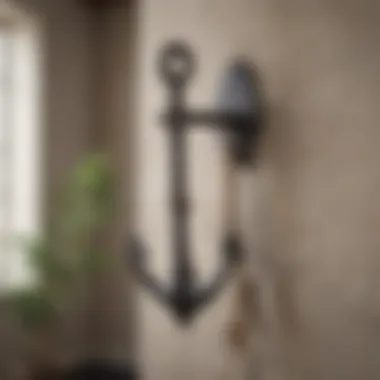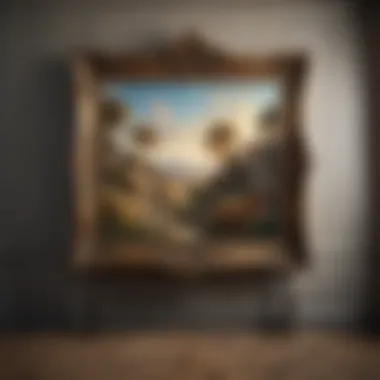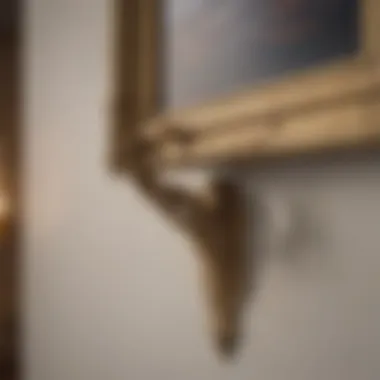Securely Hang Heavy Paintings: Expert Techniques


Intro
Hanging a heavy painting requires more than simply choosing a spot on the wall. It involves understanding the dynamics of weight, the material of your wall, and the right tools to achieve a secure installation. Homeowners and art lovers alike must navigate a web of considerations to ensure both the safety of the artwork and the aesthetics of the space. This guide aims to demystify the process, providing invaluable insights into each aspect involved in hanging heavy paintings, enabling a confident and informed approach.
Art is not just decoration; it is an expression of taste and personality. In many homes, large artworks serve as focal points, enhancing the ambiance of a room. However, improper installation can lead to damage, loss, or even injury. Thus, an understanding of techniques, tools, and safety precautions is paramount. This guide outlines these critical components in depth.
By analyzing different hanging methods, tools, and materials, readers can better appreciate the complexity of displaying art. Whether you are an experienced curator of your space or just starting to explore the world of art, the details shared in this guide are fundamental to achieving a successful outcome.
Intro to Hanging Heavy Paintings
Hanging heavy paintings can be a task that appears straightforward, but it involves various considerations. This section serves as a foundation for understanding the intricacies of hanging artwork securely. A strong grasp of the techniques and materials involved can prevent damage to both the artwork and the wall.
Understanding the Challenges
One of the primary challenges when hanging a heavy painting is ensuring that the wall can support its weight without compromising structural integrity. Different wall materials, such as drywall, brick, or concrete, affect the choice of hardware and anchoring techniques. Incorrect installation may lead to not only a fallen painting but also potential damage to the wall. Additionally, irregularities in wall surfaces may cause uneven weight distribution, requiring thoughtful planning and execution.
It is also important to consider where the painting will be displayed. Factors such as sunlight exposure, humidity, and temperature can influence the condition of the painting over time. For example, artwork hung in a high-humidity area may warp or deteriorate faster than one that is not exposed to such conditions.
Importance of Proper Hanging Techniques
Proper hanging techniques are essential to ensure the safety and longevity of both the painting and the wall. Utilizing the correct methods can mean the difference between a secure piece of art and potential disaster. Hanging techniques dictate how well the weight is distributed and, consequently, how the painting withstands external forces like vibrations or accidental bumps.
Using heavy-duty anchors, choosing the right hooks, and selecting appropriate hanging devices can prevent mishaps. These technical details are not just mere suggestions; they serve a crucial role in maintaining the aesthetic beauty of the painting while providing necessary support.
Moreover, a well-hung piece greatly enhances the overall visual appeal of a room. It communicates a sense of intention and professionalism in decor. Ensuring that heavy artworks, in particular, are mounted correctly adds to the harmony of the space they inhabit.
Assessing the Painting's Weight
Assessing the weight of a heavy painting is fundamental to ensuring its safe and secure display. Ignoring this aspect can lead to a range of issues, from damaging the wall to having the painting fall and get ruined. Understanding the weight helps in selecting the correct hanging method and materials and ensures that the wall can sufficiently support the painting.
Measuring the Dimensions
Before determining the painting's weight, measuring its dimensions is necessary. The weight of a piece often correlates with its size. Measure the height, width, and depth if applicable. Use a tape measure for accuracy. Record these measurements carefully, as they play a key role in further assessments.
Next, consider the materials used in the artwork. Paintings made on canvas may weigh less than those framed with heavy wood. Additionally, decorative elements like embellishments can add to the overall weight. Understanding the dimensions helps predict how securely the painting will attach to the wall and informs decisions about the type of hangers needed.
Determining the Weight
Once you have the dimensions, the next step is to determine the weight of the painting. If you cannot find the weight on the artist’s website or gallery details, using a digital scale can provide an accurate reading. Support the painting gently on the scale, ensuring it’s stable during measurement. For very heavy pieces, enlist the help of a person to hold the painting steady.
Knowing the weight allows you to select appropriate wall anchors and hooks. Generally, a painting weighing over 10 pounds requires specific heavy-duty solutions. A good rule of thumb is to use wall anchors that can support at least double the weight of the painting. This ensures your heavy artwork is displayed securely without risk of fallen damage.
"Understanding the weight of your painting is crucial not just for aesthetics, but for safety as well."
Choosing the Right Location
Choosing the right location for hanging a heavy painting is crucial. It not only determines the aesthetic appeal but also affects the painting's safety and longevity. The proper placement can enhance the overall atmosphere of your space. Moreover, a well-placed painting attracts attention, while a poorly selected spot might make it almost go unnoticed. This section will cover essential elements to consider, including wall space analysis, lighting, and height.
Analyzing Wall Space
Before hanging a heavy painting, you must analyze your wall space thoroughly. Not all walls are created equal. Some may be sturdy enough to carry a significant weight, while others can falter under pressure. Consider these factors:
- Surface type: Is the wall drywall, brick, or plaster?
- Stud location: It is essential to locate wall studs using a stud finder. Hanging directly on studs often provides the best support for your painting.
- Width and height: Measure the dimensions of the painting in relation to the wall. Find a location where the painting can be the focal point without overcrowding the space or overwhelming surrounding decor.
A well-thought-out location elevates the visual impression of any room.
Considerations for Lighting


Lighting is another critical factor when hanging a heavy painting. The right lighting can enhance colors and details, making the painting more vibrant. On the contrary, poor lighting can lead to shadows and diminish its visual impact. Here are points to remember:
- Natural Light: Avoid placing a painting in direct sunlight. UV rays can fade colors over time, damaging your artwork.
- Artificial Lighting: Consider using track or recessed lighting to highlight the painting. Adjustable fixtures allow you to direct light and control how the painting looks at different times of day. It ensures that the artwork remains a center of attention, regardless of natural lighting conditions.
Balancing lighting creates an inviting ambiance.
Height and Viewing Angles
Finally, height and viewing angles play an essential role in the successful display of your painting. Ideally, the center of the artwork should be at eye level. If the painting is too high or low, it can be uncomfortable for viewers. Consider the following:
- Eye Level Height: For most people, the optimum eye level is roughly 57 to 60 inches from the floor. This height engages the viewer and invites appreciation of the work.
- Viewing Distance: Account for the distance viewers will typically stand from the artwork. A larger picture might require a bit more height to keep it well-placed in harmony with surrounding furniture and space.
By carefully considering these aspects, you can achieve a polished, well-done look for your painting.
"The right location, lighting, and height create a balanced display that enhances both the artwork and the overall space."
Taking the time to thoughtfully evaluate these factors results in not just a practical solution for hanging heavy paintings but also an aesthetically pleasing outcome.
Tools and Materials Needed
Hanging a heavy painting may seem straightforward, yet this process demands specific tools and materials to achieve a secure and stable display. The right tools make a significant difference in ensuring the artwork is positioned correctly while minimizing the risk of damage to both the wall and the painting itself. By understanding what is necessary for successful installation, one can prevent mishaps and ensure a satisfying outcome.
Essential Tools for Hanging
When preparing to hang a heavy painting, it is crucial to gather essential tools that will facilitate the process. Here is a list of tools that you should consider:
- Level: Ensures that the painting is straight, providing a pleasing aesthetic.
- Measuring Tape: Essential for measuring height and distance accurately.
- Pencil: Used for marking where the anchors will go.
- Drill: Particularly important for drilling pilot holes in the wall.
- Screwdriver or Hammer: Required for securing the hanging hardware.
- Stud Finder: Useful to locate studs in the wall for better weight distribution.
Additionally, using a ladder might be necessary if the painting is to be hung at a height. Each tool plays a role in ensuring the painting is both secure and appropriately displayed.
Flexible Hanging Solutions
Flexible hanging solutions include various methods and materials designed to accommodate different wall types and hanging preferences. Some options enable adjustments after installation, which is particularly useful when aesthetic preferences change or wall characteristics differ. Key solutions include:
- Picture Wire: Allows for slight repositioning of the painting without the need for tools once hung.
- D-Rings: These can securely attach to the back of the painting and can be used with cables for added support.
- French Cleats: A sturdy and reliable method, optimal for heavy paintings. They distribute the weight evenly and enable easy leveling after hanging.
- Heavy-Duty Hooks: Offer strong support, particularly useful for large and cumbersome items.
Each flexible solution has distinct benefits depending on the specifics of the painting and the wall structure. The key factor is ensuring that whatever method utilized can support the painting's weight safely and securely, thereby maintaining the integrity of both the painting and the wall its displayed on.
Understanding these tools and materials is essential for achieving a successful display of heavy art, allowing for an arrangement that is both visually appealing and secure.
Types of Wall Anchors
Hanging heavy paintings involves more than just selecting the right spot on your wall. A significant part of the process focuses on choosing the correct wall anchors. The type of anchors used is crucial to ensure that the weight of the painting is adequately supported. Proper anchoring can prevent damage to both the wall and the artwork. Understanding the various wall types and selecting suitable anchors contribute to a successful hanging process.
Understanding Different Wall Types
Different walls have varied structures and materials, affecting how weight is distributed. It is vital to identify the wall type before proceeding with any installation. Common wall types include:
- Drywall: This is the most prevalent type in modern homes. It consists of a gypsum core sandwiched between two sheets of heavy paper. While drywall is easy to work with, it requires specific anchors to support heavy objects.
- Plaster: Older homes often have plaster walls. These walls tend to be thicker but can be more brittle. Special care is needed when using anchors, as improper installation can lead to crumbling or damage.
- Concrete or Brick: These walls provide solid support and can bear substantial weight when properly anchored. However, tools for drilling into these materials are necessary.
- Wood Studs: Walls with wood studs can support heavy items if you hang directly on the studs. Using a stud finder can help locate these support areas.
Knowing the wall type helps in selecting the right anchors and ensures a secure fit.
Selecting the Appropriate Anchors
Once you have identified the wall type, choose the appropriate anchors designed to handle the weight of the painting. This process involves considering the following:
- Weight Rating: Each anchor type has a specific weight limit. Ensure the chosen anchors match or exceed the painting's weight. For example, toggle bolts or molly bolts can hold heavier loads on drywall compared to standard hooks.
- Size and Depth: The size of the anchor should fit the wall type. For instance, a larger anchor may be required for brick walls, while smaller ones work for drywall associated with lighter weights.
- Style of Anchor: Various types like expansion anchors, toggle bolts, or screw anchors have different advantages. Each is suited for particular conditions and weights.
Recommendations for Common Scenarios:


- For Drywall: Use toggle bolts or heavy-duty screws.
- For Concrete/Brick: Opt for masonry screws or expansion anchors.
- For Plaster: Use wall anchors that prevent damage during installation.
A correctly selected anchor ensures stability and safety, safeguarding both your artwork and wall integrity.
Understanding wall types and selecting appropriate anchors is paramount for securely hanging heavy paintings. Taking these steps enhances the longevity of your installations and reduces the risk of accidents.
Hanging Techniques for Heavy Paintings
Hanging a heavy painting is not merely a matter of aesthetics; it also involves a technical understanding of the methods and techniques that ensure safety, integrity, and visual appeal. The importance of proper hanging techniques cannot be overstated. A heavy painting requires reliable support to prevent accidents and damage, placing a significant emphasis on the methods one selects.
When hanging heavy art, it is crucial to consider the weight distribution, the materials used for hanging, and the type of wall you are working with. Choosing an inadequate technique can lead to the painting falling or causing structural damage to the wall. Therefore, understanding various hanging techniques is essential for maintaining the condition of both the artwork and the wall itself. This section explores several effective methods commonly used to hang heavy paintings.
Using Picture Wire and D-Rings
Using picture wire and D-rings is a traditional method that balances both strength and flexibility. Picture wire adds an extra layer of support, allowing the weight of the painting to be distributed evenly. The D-rings, which attach to the back of the painting, offer a stable anchor point for the wire.
Here's how to implement this method:
- Attach D-Rings: Fasten D-rings to each side of the painting's frame, ensuring they are equidistant from the sides.
- Cut the Wire: Measure and cut enough picture wire to create a secure loop. The wire should be at least three times the width of the painting.
- Thread the Wire: Thread the wire through the D-rings, creating a taut but not overly tight loop. This allows some movement, which can help reduce the risk of breakage.
- Hang on the Wall: Use appropriate anchors or hooks to secure the wire on the wall. This method allows for slight adjustments once the painting is hung, enabling a perfect final position.
Employing Heavy-Duty Hooks
Heavy-duty hooks are straightforward and offer a direct means of supporting wall art. These hooks are designed specifically for heavier loads and can accommodate various wall types, from drywall to plaster.
When using heavy-duty hooks:
- Choose the Right Hook: Look for hooks that have a high weight rating. Brands like Hillman provide reliable options for heavy artworks.
- Install Correctly: Ensure the hook is properly installed into a stud when possible; this ensures maximum weight-bearing capacity. If wall studs are not available, use appropriate wall anchors suitable for your wall type.
- Check Weight Limits: It is essential to check the hook’s weight limit and ensure that it is compatible with the weight of your painting.
Utilizing French Cleats
French cleats provide a secure and robust method for hanging heavy paintings. This technique involves two wooden strips, one attached to the wall and the other to the back of the painting. The design allows the painting to be hung securely while being easily removable for adjustments.
To employ this technique:
- Cut Cleat Strips: Cut two strips of wood at a 45-degree angle. The length can vary based on the painting’s size.
- Attach One Cleat to the Wall: Securely attach one strip to the wall with appropriate screws. The angled edge should face upwards.
- Attach the Second Cleat to the Painting: Affix the second strip to the back of the painting, ensuring the angle mirrors that of the wall cleat.
- Hang the Painting: Simply lift the painting and place the upper cleat over the lower one. This method allows for easy adjustments and ensures the painting is well-supported.
In summary, the choice of hanging technique plays a significant role in securing heavy paintings. Each method discussed has its advantages, and selecting the right one depends on the specific requirements of your space and the artwork itself.
By carefully considering your choices, you can ensure a secure and visually appealing display.
Installation Process
The installation process is a critical phase when hanging a heavy painting. This step determines not only the aesthetic outcome but also the safety and durability of the installation. It involves precise measurements, proper marking, and secure placements to ensure that the artwork remains adorning the wall without risk of falling. Each element of this stage contributes to a successful hanging, minimizing potential hazards that can damage both the artwork and the wall behind it.
Preparing the Wall
Before proceeding with the installation, preparing the wall is essential. This preparation includes a thorough inspection of the wall for issues such as cracks, peeling paint, or dampness. A smooth and stable surface is crucial for a successful installation. Clean the wall to remove dust and residues. This will help in better adhesion if you use wall anchors or any adhesive products.
Additionally, determine what type of wall you are dealing with. Different materials such as drywall, plaster, or concrete require different approaches and tools. For drywall, you may need special anchors. For concrete, consider using masonry screws with specific plugs.
"Properly preparing the wall sets the foundation for the entire hanging process and can prevent many common issues later on."
Marking the Hanging Points
Once the wall is prepared, the next step involves marking the hanging points. This step is critical to ensuring the painting is displayed at the desired height and alignment. Use a level to maintain straight lines and accurate positioning. Start by measuring the center of the painting, marking that point on the wall. Then, measure the distance from the top of the painting to the hanging hardware. Transfer this measurement onto the wall, ensuring that you account for the height and sightlines in the room.
Using a pencil for marking is essential—this allows for quick adjustments if needed, unlike ink or permanent markers. Double-check the marks for accuracy before proceeding to the next step.


Securing Anchors and Hooks
The securing of anchors and hooks is where the importance of safety significantly increases. The choice of anchor will depend on the wall material and the weight of the painting. For heavier pieces, toggles or other heavy-duty anchors provide greater support compared to standard nails or screws. Install the anchors where you have marked the points, following the product instructions closely.
Once the anchors are secure, attach the hooks. It’s crucial to use hooks that are rated for the weight of the painting. Heavy-duty wall hooks, like those from the brands Wall Dog or Monkey Hooks, can support substantial weight and ensure longevity.
Hanging the Painting
Finally, you can hang the painting. Gently lift the artwork and align it with the hooks or D-rings previously installed. Avoid rushing during this step—take your time to make sure the painting is level and properly positioned. Adjust it as necessary to achieve the desired look.
After the painting is in place, step back to assess its appearance in the room. Look at it from different angles to ensure its placement feels right and sits well within the space. Adjustments can be made if needed.
Following this method ensures that the heavy painting is not only secure but also enhances the visual appeal of the room.
Safety Considerations
Hanging heavy paintings is not merely an aesthetic task, but it also involves critical safety considerations. These considerations are vital to ensure both the integrity of your artwork and the safety of your home and its occupants. The choice of appropriate techniques and tools can minimize risks such as falling art, wall damage, or personal injury. Neglecting these aspects can lead to significant issues, ranging from minor inconveniences to severe accidents.
Assessing Wall Integrity
Before hanging a heavy painting, assessing the integrity of your wall is paramount. Not all wall materials can support the same weight. For example, drywall, while common, may not provide adequate support without proper anchors. On the other hand, concrete or brick walls typically offer a stronger foundation. To evaluate the wall's integrity:
- Use a stud finder to locate underlying supports.
- Consider wall type: Is it plaster, drywall, or something else?
- Inspect for damage: Look for cracks or weakness that could compromise stability.
Also, the age of the wall can influence its capability. Old plaster may crumble under weight, while new drywall installed correctly may hold better. Make use of your observations to inform your anchoring decisions, ensuring the chosen method will safely support the painting.
Avoiding Potential Hazards
Beyond the wall's structural integrity, various hazards can arise during the hanging process. Awareness of these potential risks can save you from accidents. First, ensure to keep the area clean and free from obstructions. This will minimize tripping hazards while maneuvering heavy objects.
Additionally, correct tools usage is crucial. Using a ladder improperly or using the wrong types of anchors can lead to incidents. Here are some measures to help avoid hazards:
- Wear protective gear, such as gloves and goggles, particularly when handling heavy frames or sharp tools.
- Secure ladders properly: Ensure they are stable and on a flat surface.
- Involve a partner: Having someone assist with heavy items can prevent accidents caused by overexertion or loss of balance.
Remember: Safety should always be your priority when handling heavy paintings. Proper preparation and awareness can greatly reduce possible risks during the installation process.
Maintaining the Painting's Condition
Maintaining the condition of a heavy painting is crucial for preserving its value, aesthetics, and integrity over time. Once the painting is hung, attention must shift to its care as environmental factors can lead to deterioration. Several elements play a role in maintaining a painting, such as humidity levels, light exposure, and regular upkeep. By adopting effective cleaning practices and conducting routine inspections, one can ensure the longevity of the artwork. This aspect of ownership is not only beneficial in terms of maintaining aesthetics but also essential for protecting investment.
Cleaning and Care
Regular cleaning is one of the fundamental responsibilities for any art owner, especially when it comes to heavy paintings. Dust and grime can accumulate on the painting surface, leading to a dull appearance over time. To avoid this, it is advisable to use a soft, dry cloth to gently wipe the surface and remove any dust. Avoid using cleaning products that contain chemicals, as these can cause damage to the painting's finish. For more thorough cleaning, it is wise to consult an art conservator who can offer specialized advice based on the painting’s medium.
Additionally, humidity control is important. Paintings left in highly humid environments can suffer from mold, while dry conditions can lead to cracking in the paint or canvas. A well-regulated room with stable humidity levels will help protect the condition of the painting. Simple measures like using a dehumidifier or air conditioning can significantly improve the environment.
Regular Inspections
Conducting regular inspections of the painting ensures that any issues can be identified and addressed in a timely manner. Look for signs of deterioration such as flaking paint, discoloration, or signs of mold. Checking the hanging mechanism is also advisable, as over time, the weight of heavy paintings can loosen screws or anchors. If any problems are detected, such as a warped frame or rusting hooks, prompt action is necessary to prevent further damage.
Regular checks will not only maintain the painting’s physical appearance but can also help preserve its emotional value by ensuring its beauty for years to come.
Finale
Hanging heavy paintings is more than a mere decorative task; it is an activity that combines art with practical engineering. Throughout this guide, we emphasized the importance of proper techniques, safety considerations, and the right tools. This careful approach ensures that your valuable artwork not only adorns your space but does so safely.
Recap of Key Points
- Assess the Weight and Size: Knowing how much your painting weighs is fundamental. This helps in selecting the correct hardware.
- Choose Suitable Anchors: Depending on your wall type, choosing the right wall anchors plays a crucial role in securing your painting.
- Utilize Effective Techniques: Various methods, such as using D-rings, heavy-duty hooks, or French cleats, provide options that suit different conditions.
- Safety Standards: Always assess the wall integrity and ensure that your hanging methods do not pose hazards to your space.
- Maintenance: Regular inspections and care of the artwork will extend its lifespan and maintain its visual appeal.
Encouragement to Apply Techniques
After going through the methods and processes outlined in this article, it is beneficial to actively apply these techniques. When hanging a heavy painting, remember that you not only engage in an aesthetic venture but also in a responsibility toward preserving the artwork’s integrity. Take the time to prepare properly, select the right tools, and implement the appropriate hanging techniques. This diligence collectively enhances not just the presentation of your art but also contributes to the atmosphere of your living space.
By employing these techniques, art enthusiasts and homeowners alike can confidently display their favorite pieces without fear of damage or accidents. Consider this not merely as a set of instructions but as an invitation to explore the intersection of art and practicality in your own home.















